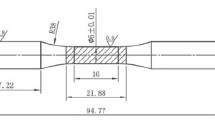Abstract
A new inclusions rating method using hydrogen embrittlement of a tensile test specimen is proposed. This method is essentially based on the statistics of extremes for inclusion rating where the maximum inclusion size is determined by simple tensile testing of a hydrogen-precharged (H-precharged) specimen. Tensile tests were conducted using two bearing steels (SAE52100 HV 346, HV 447, HV 559, HV 611, HV 678 and ASTM-A485-1 HV 706, HV 715) and one spring steel (SAE5160, HV 651). Fatigue tests were conducted using SAE52100 bearing steel (HV 682). All H-precharged tensile specimens (SAE52100, ASTM-A485-1 and SAE5160) were fractured from internal inclusions except the SAE52100 tensile specimens with a Vickers hardness of HV 346. It was confirmed that the distribution of extreme values of inclusion sizes obtained by SAE52100 tensile testing with H-precharged specimens coincided with those obtained by SAE52100 fatigue testing. From these results, it is presumed that the inclusion rating method by fatigue testing can be replaced by simple tensile testing with H-precharged specimens. The proposed method is more convenient and reliable than other existing inclusion rating methods, i.e., fatigue testing and optical microscopy. The proposed method can be applied to specimens with a Vickers hardness of higher than HV 447.





















Similar content being viewed by others
References
Y. Murakami: Metal Fatigue: Effect of Small Defects and Nonmetallic Inclusions, Elsevier, Oxford, U.K., 2002.
P.H. Frith: J. Iron Steel Inst., 1955, vol. 180, pp. 26–33.
Y. Murakami, S. Kodama, and S. Konuma: Int. J. Fatigue, 1989, vol. 11, pp. 291–98.
ASTM E2283-08: Standard Practice for Extreme Value Analysis of Nonmetallic Inclusions in Steel and Other Microstructural Features, ASTM, West Conshohocken, PA, 2008.
Y. Murakami, M. Takada, and T. Toriyama: Int. J. Fatigue, 1998, vol. 20, pp. 661–67.
S. Zhou, Y. Murakami, Y. Fukushima, and S. Beretta: Tetsu-to-Hagane, 2001, vol. 87, pp. 748–55.
S. Zhou, Y. Murakami, S. Beretta, and Y. Fukushima: Mater. Sci. Technol., 2002, vol. 18, pp. 1535–43.
S. Beretta and Y. Murakami: Metall. Mater. Trans. B, 2001, vol. 32, pp. 517–23.
Y. Furuya, S. Matsuoka, and T. Abe: Metall. Mater. Trans. A, 2003, vol. 34, pp. 2517–26.
R.M. Vennet and G.S. Ansell: Trans. Am. Soc. Met., 1967, vol. 60, pp. 242–51.
H. Cialone and R.J. Asaro: Metall. Trans. A, 1979, vol. 10A, pp. 367–75.
Y. Murakami and S. Matsuoka: Eng. Fract. Mech., 2010, vol. 77, pp. 1926–40.
Y. Murakami, S. Matsuoka, Y. Kondo, and S. Nishimura: Mechanism of Hydrogen Embrittlement and Guide for Fatigue Design, Youkendo, Co., Ltd., 2012.
S. Fukui: Tetsu-to-Hagane, 1969, vol. 55, pp. 151–61.
JIS G 0555: Microscopic Testing Method for the Non-Metallic Inclusions in Steel, Japanese Standards Association, Tokyo, 2008, pp. 682–712.
A. Adachi, H. Shoji, A. Kuwabara, and Y. Inoue: Electr. Furnace Steel, 1975, vol. 46, pp. 176–82.
T. Matsuo, N. Homma, S. Matsuoka, and Y. Murakami: JSME Trans. A, 2008, vol. 74, pp. 1164–73.
Y. Murakami, T. Kanezaki, Y. Mine, and S. Matsuoka: Metall. Mater. Trans. A, 2008, vol. 39A, pp. 1327–39.
Y. Murakami and J. Nagata: Trans. Jpn. Soc. Mech. Eng. A., 2004, vol. 70, pp. 1093–1101.
R. Takahashi and M. Shibuya: Ann. Inst. Stat. Math., 1996, vol. 48, pp. 127–44.
R. Takahashi and M. Shibuya: Ann. Inst. Stat. Math., 1998, vol. 50, pp. 361–77.
Y. Furuya: Tetsu-to-Hagane, 2009, vol. 95, pp. 426–33.
Acknowledgments
The authors would like to thank Professor D. Socie and Professor P. Sofronis of University of Illinois and Dr. B. Somerday of Sandia National Laboratory for their useful discussion and comments. This research has been supported by the NEDO project “Fundamental Research Project on Advanced Hydrogen Science (2006–2012)”. The authors gratefully acknowledge the support of the International Institute for Carbon-Neutral Energy Research (WPI-I2CNER), sponsored by the Japanese Ministry of Education, Culture, Sport, Science and Technology.
Author information
Authors and Affiliations
Corresponding author
Additional information
Manuscript submitted February 22, 2012.
Rights and permissions
About this article
Cite this article
Fujita, S., Murakami, Y. A New Nonmetallic Inclusion Rating Method by Positive Use of Hydrogen Embrittlement Phenomenon. Metall Mater Trans A 44, 303–322 (2013). https://doi.org/10.1007/s11661-012-1376-1
Published:
Issue Date:
DOI: https://doi.org/10.1007/s11661-012-1376-1




